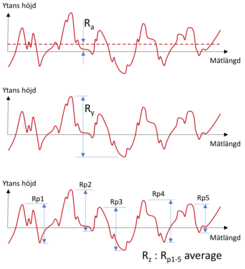When cutting to shape the strived geometrical shape the surface is affected by deformation which causes the material properties in the surface to change.
Geometric result
The geometric surface condition of the machined surface is the result of the cutting tool's design and feed rate, which gives a theoretical surface smoothness. However, this does not take into account irregularities caused by vibrations in the tool/machine, elasticity of the workpiece, edge built-up, tool wear or variations in the depth position of inserts in multiple insert milling tools.
For more info see technical terms Read more in Roughness in turning and Surface roughness in milling.
Work hardening
When the material in the surface is removed it causes the remaining material to deforms rusulting in deformation hardening. The degree of hardening is linked to the specific material's work hardening ability.
Microcracks
When machining especially harder materials, microscopic geometric changes occur in the form of micro-cracks. Since they are so small in sizes they do not effect the surface smoothness but they might effect the material's strength as they can drastically lower the limit of crack growth.
